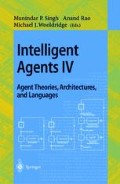Abstract
In this paper the architecture and implementation of Cooperative Information Agents (CIA) is described. Taking a language-action perspective to the design of CIAs allows for the specification of obligations and authorizations, and results in the separation of tasks (things the agent must do) and contracts (mutually agreed commitments to the course of communication). The architecture describes the functional components of a CIA: task manager (responsible for managing the agenda), contract manager (managing and negotiating contracts), communication manager (responsible for all external communication), and service execution manager (managing the execution of actions). The prototype agents show how a formal logical theory for communicating agents can be used as a sound basis for an actual implementation.
Preview
Unable to display preview. Download preview PDF.
References
P. Cohen and H. Levesque. Communicative Actions for Artificial Agents. In Int. Conf on Multi-Agent Systems, pages 65–72, 1995.
K. Decker and V Lesser. Task environment centered design of organizations. In AAAI Spring Symp. on Computational Organization Design. Stanford, 1994.
F. Dignum. Social Interactions of Autonomous Agents: Private and Global Views on Communication. In P.-Y Schobbens, editor, Proc. of 3rd workshop of the ModelAge Project, Sienna, Italy, 1997.
F. Dignum and B. van Linder.Modeling Rational Agents in a Dynamic Environment: Putting Humpty Dumpty Together Again. In J.L. Fiadeiro and P.-Y. Schobbens, editors, Proc. of 2nd workshop of the ModelAge Project, pages 81–92, Sesimbra, Portugal, 1996.
F. Dignum and H. Weigand. Communication and Deontic Logic. In R. Wieringa and R. Feenstra, editors, Information Systems, Correctness and Reusability, pages 242–260, Singapore, 1995. World Scientific.
F. Dignum and H. Weigand. Modeling Communication between Cooperative Systems. In J. Iivari et. al., editor, Proc. of CAISE'95, pages 140–153, Berlin, 1995. Springer-Verlag.
A. Elmagarmid. Database Transaction Models for Advanced Applications. Morgan Kaufman, 1992.
T. Finin, R. Fritzson, D. McKay and R. McEntire. KQML: a language and protocol for knowledge and information exchange. In M. Klein et. al., editor, Distributed AI-13th Int. l. WS, pages 99–103, Menlo Park, CA., 1994. AAAI Press.
Fipa. http://drogo.cselt.stet.it/fipalindex.htm.
F. Flores and J.J. Ludlow. Doing and speaking in the office. In G. Fick et. al., editor, DSS: Issues and Challenges, pages 95–118, New York, 1980. Pergamon Press.
R. Frost. The jat. http.://Cdrstanford.edulABEIJavaAgent.html.
J. Habermas. The Theory of Communicative Action: Reason and the Rationalization of Society, Volume One. Beacon Press, Boston, 1984.
B. Moulin and B. Chaib-draa. An overview of distributed artificial intelligence. In H. O'Hare and N. Jennings, editors, Foundations of DAI, pages 3–55, New York, 1996. John Wiley and Sons Inc.
A.H.H. Ngu, R.A. Meersman and H. Weigand. Specification and verification of communication for interoperable transactions. In Int.l. Journal of Intelligent and Cooperative Information Systems, vol. 3, no. 1, pages 47–65, 1994.
T. Norman, N. Jennings, P. Faratin and E. Mamdani. Designing and Implementing a Multi-Agent Architecture for Business Process Management. In M. Wooldridge J. Mueller and N. Jennings, editors, Intelligent Agents III-Proceedings ATAL-96, pages 149–162, 1996.
M. Papazoglou. An organizational framework for intelligent cooperative IS. IJICIS-1(1), 1992.
J.R. Searle. Speech Acts. Cambridge University Press, 1969.
J.R. Searle and D. Vanderveken. Foundations of illocutionary logic. Cambridge University Press, 1985.
E.M. Verharen. A Language-Action Perspective on the Design of Cooperative Information Agents. PhD thesis, Katholieke Universiteit Brabant, 1997.
E.M. Verharen and F. Dignum. Cooperative Information Agents and Communication. In M. Klusch, editor, Proc. of the 1st Int.l. WS on CIAs, Berlin, 1997. Springer-Verlag.
Author information
Authors and Affiliations
Editor information
Rights and permissions
Copyright information
© 1998 Springer-Verlag Berlin Heidelberg
About this paper
Cite this paper
Verharen, E.M., Dignum, F., Bos, S. (1998). Implementation of a cooperative agent architecture based on the language-action perspective. In: Singh, M.P., Rao, A., Wooldridge, M.J. (eds) Intelligent Agents IV Agent Theories, Architectures, and Languages. ATAL 1997. Lecture Notes in Computer Science, vol 1365. Springer, Berlin, Heidelberg. https://doi.org/10.1007/BFb0026748
Download citation
DOI: https://doi.org/10.1007/BFb0026748
Published:
Publisher Name: Springer, Berlin, Heidelberg
Print ISBN: 978-3-540-64162-9
Online ISBN: 978-3-540-69696-4
eBook Packages: Springer Book Archive

